Gion Festival 2025 in Kyoto: Dates, History, Paid Seats, Tips

Kyoto's Gion Matsuri Festival is an annual event held in July. Learn how to get paid viewing seats for the main parades, the festival's history, dates and tips.
Gion Matsuri, Kyoto’s One-Thousand-Year Old Festival

Photo by Pixta
Kyoto's Gion Matsuri, or the Gion Festival, held every year in July, is one of Japan’s three great festivals, alongside Osaka’s Tenjin Festival and Tokyo’s Kanda Festival.
In 2009, the Gion Matsuri in Kyoto was designated as UNESCO Intangible Cultural Heritage. The gigantic yamaboko (festival floats) parading through the city center are iconic for Kyoto’s summer days.
The Gion Festival is originally a festival of Yasaka Shrine, located in the heart of Kyoto's Gion district.
Its beginnings date back over 1,000 years ago, to the year 869! It is said that in that year, a plague spread across Japan, causing many deaths. To quell this epidemic, a festival called Goryō-e was held. This marks the beginning of Gion Matsuri.
Since then, although it has been interrupted several times due to domestic wars and other conflicts, each time it was revived through the efforts of the people, and it has continued to be a part of Kyoto’s history.
In this article, we will thoroughly explain the schedule, access, and highlights of Gion Matsuri.
Kyoto Gion Festival 2025 Guide
1. Gion Festival 2025 Dates and Event Schedule
2. How to Enjoy the Gion Festival: Paid Viewing Seats
3. Gion Festival: History
4. Yamaboko Floats, the Highlights of the Gion Matsuri
5. Venue of the Gion Matsuri Parade
6. Festival Tips: Food Stalls, Weather, Toilets, Money
Limited Number! Paid Viewing Seats for Gion Matsuri
1. Gion Festival 2025 Dates and Event Schedule
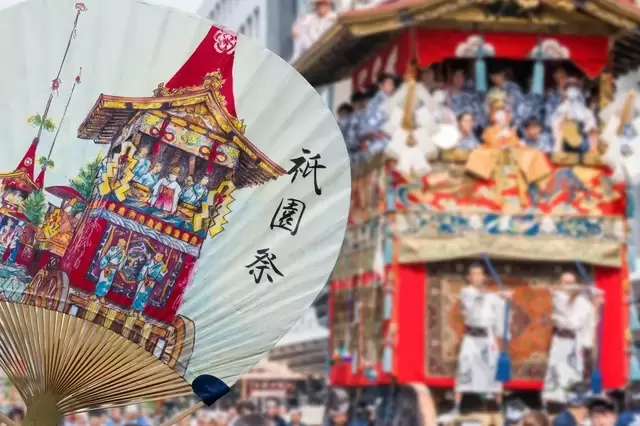
Photo by Pixta
Gion Matsuri is held over roughly one month, from July 1st to July 31st every year. The schedule remains the same every year, regardless of the day of the week.
Check the dates of the main events and parades below.
Kyoto Gion Matsuri 2025 Schedule
Kyoto's Gion Matsuri 2025 is scheduled to be held from July 1 to July 31, 2025.
- Yoiyama (Pre-festival): July 14 (Mon) – 16 (Wed)
- Food Stall Vendors: July 15 (Tue) – 16 (Wed)
- Yoiyama (Main Festival): July 21 (Mon) – 23 (Wed)
- Yamaboko Parade (Main Festival): July 17 (Thu)
- Yamaboko Parade (End Festival): July 24 (Thu)
The festival is at its peak during the three days of the Yoiyama (night festival) on July 14 -16, as well as during the Saki matsuri yamaboko parade. One week afterward, the Ato matsuri starts with its amazing yamaboko parade.
On July 15 and 16, during the Yoiyama, the main streets of Shijo-dori and Karasuma-dori become a pedestrian heaven. There are food stands all along the road.
The stations closest to the venue of Gion Matsuri are Karasuma Station and Kawaramachi Station of the Hankyu Railway, as well as Gion-Shijo Station of Keihan Electric Railway.
2. How to Enjoy the Gion Festival: Paid Viewing Seats

Picture courtesy of Klook © Kyoto City Tourism Association
The highlight of the Gion Festival is the Yamaboko Procession. The Yamaboko floats are meticulously crafted and paraded through the city streets by locals dressed in traditional attire.
Enhance your festival experience by securing reserved seating in advance, ensuring a comfortable and unobstructed view of the spectacular Yamaboko procession.
Paid Viewing Seats: Get Closer to Gion Matsuri
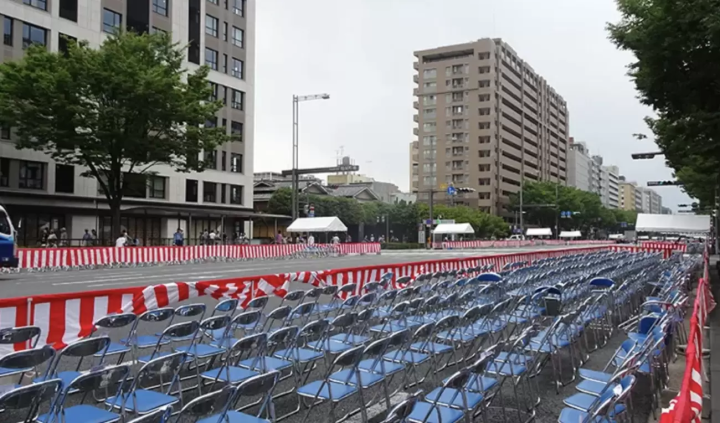
Picture courtesy of Holiday Travel
The Gion Matsuri Saki-matsuri, or Pre-Festival parade, held on July 17, 2025, can be viewed up close with paid viewing seats.
From comfortable seats set between Kawaramachi-dori Street and Nakaracho, along Oike-dori Street, you can enjoy the spectacular Yamaboko parade to your heart’s content!
Since the number of seats is limited, be sure to reserve early.
↑ Return to the top of article.
3. Kyoto's Gion Festival: History
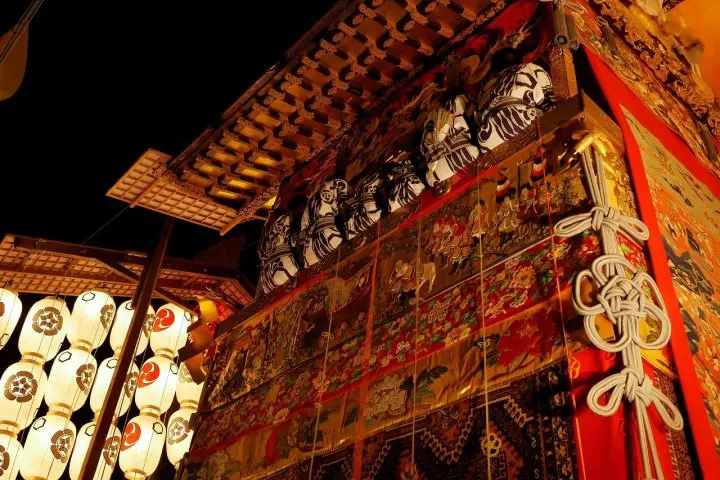
Photo by Pixta
Gion Matsuri started as a festival of Yasaka Shrine, which is located in the Gion area of Kyoto. This celebration dates all the way back to the year 869, more than one thousand years ago!
It is said that during that year, the whole country was affected by an epidemic that resulted in many deaths. The city hosted a festival called Gion-Goryoe, which was meant to appease the malevolent spirits that were thought to have caused the epidemic. This festival stands at the origin of Gion Matsuri.
There were times when the festival was canceled because of wars. However, it would always be revived and is now part of Kyoto’s history and culture.
4. Yamaboko Floats, the Highlights of the Gion Matsuri

Photo by Pixta
The greatest highlight of the Gion Festival is the yamaboko parade. Yamaboko, as mentioned above, is a type of a festival float (dashi in Japanese) that is carried around during a Shinto festival. The Kyoto yamaboko floats are about 25 meters high, and the largest ones can weigh up to 12 tons!
To let the large yamaboko pass, some adjustments have to be done to to the city roads. One of these adjustments is folding up the street lights where the yamaboko are supposed to be carried. Of course, not every street light can be folded up like this. This is only possible in the case of Gion Matsuri. The street light equipment along the route is made to be manageable in such a way.
The scene of a large number of yamaboko parading along the city avenue is astonishing. The Gion Festival is divided into the Saki matsuri (early festival) and the Ato matsuri (later festival).
23 floats are carried during the Saki matsuri and 10 floats during the following Ato matsuri, which makes it 33 floats in total. Each of the yamaboko is decorated lavishly for this occasion portraying famous Japanese legends and stories.
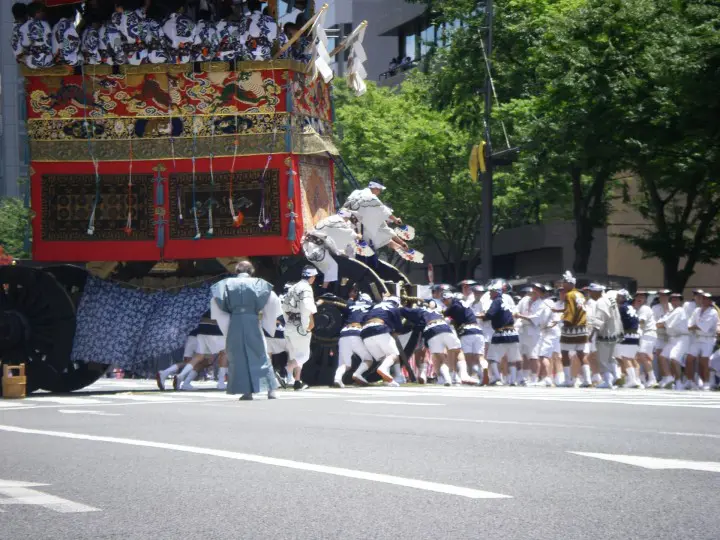
A yamaboko is usually pulled by 40 to 50 people. Gion Matsuri’s famous tsujimawashi (photo above) has a platform rotating to 90 degrees, using only human strength. It is another highlight of the festival that will leave you astonished. This is surely a sight to be witnessed in person!
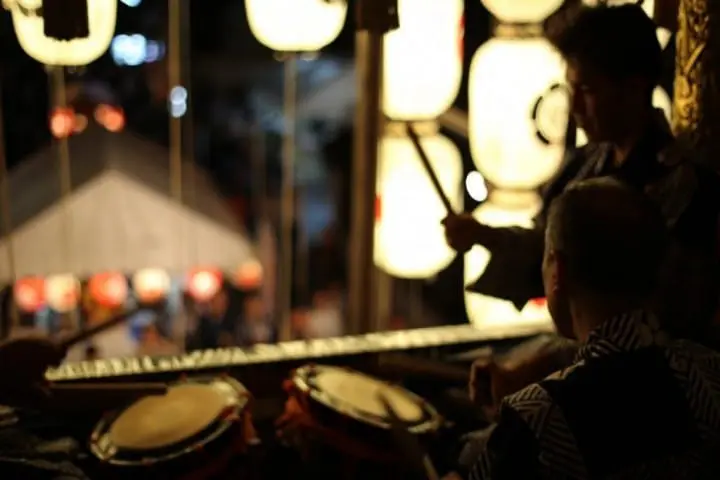
Another highlight of the yamaboko parade is Gionbayashi, the musical performance. 40 to 50 persons ride on top of the yamaboko while playing traditional musical instruments. Thanks to the magical rhythm of taiko drums, Japanese flutes, as well as the Japanese gong called "shou" in Japanese, the festival atmosphere is full of excitement.
Each year, all the yamaboko floats are assembled in preparation for the festival and are dismantled when the festival is over.
↑ Return to the top of article.
5. Venue of the Gion Matsuri Parade
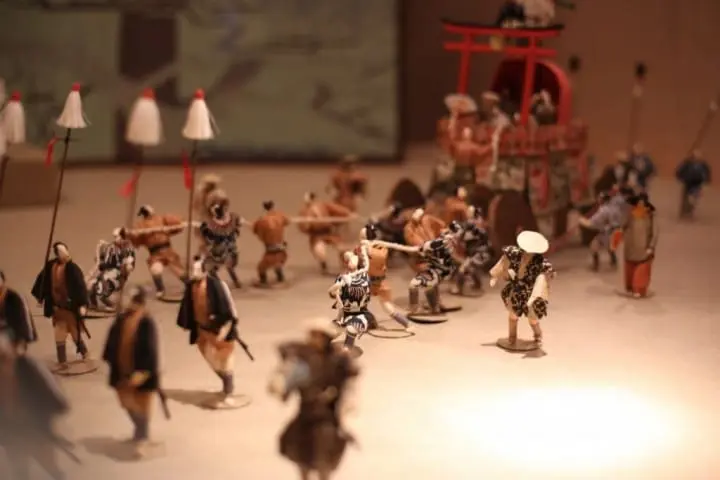
The route of the yamaboko parade goes through Shijo-dori (from Kawaramachi Station to Karasuma Station), Kawaramachi-dori (from Kawaramachi Station to Kyoto Shiyakusho-mae Station), and the Oike-dori (from Kyoto Shiyakusho-mae Station to Karasuma Oike-dori).
There are different routes on different days of the festival, so be sure to check the official website (Japanese and English) of the festival for more information.
↑ Return to the top of article.
6. Tips for Enjoying Kyoto's Gion Festival
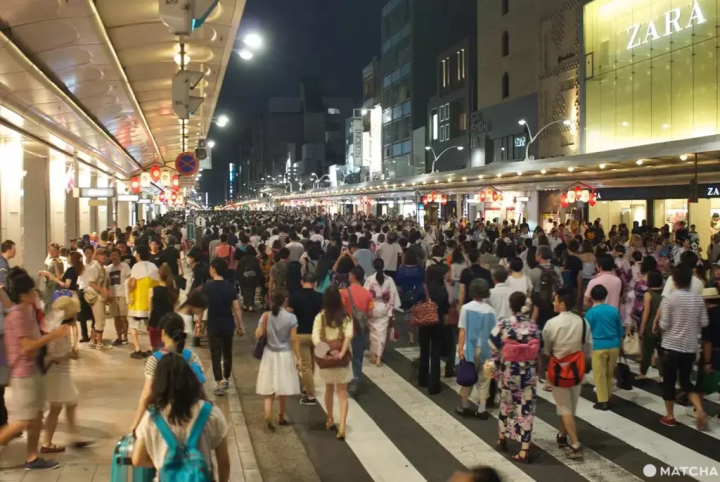
The Gion Festival features different festivities each day, which might make it confusing for newcomers to know how to best enjoy it. To assist those who may be unsure, we introduce a few way to enjoy the charm of the Gion Festival, ensuring even beginners can relax and enjoy this celebrated event with peace of mind.
1. Buy a Chimaki Special Charm at the Gion Festival
One of the specialties of the Gion Festival is the "chimaki". Chimaki is a traditional Japanese sweet made mainly from glutinous rice that is considered auspicious.
In the context of the Gion Festival, however, the chimaki is not for eating.
On the eve of the main Yamaboko procession, the chimaki are given out and are meant to be hung at one's doorstep for the entire year as "yakuyoke", which is a charm for warding off evil. You can often find these "yakuyoke chimaki" displayed at the entrances of homes in Kyoto.
Prices range from around 800 to 1,000 yen per charm, available for purchase on various street corners where the floats are stationed. Since the blessings of each charm differ depending on the float, make sure to choose one that aligns with your specific wishes.
2. Enjoy Kyoto's Gourmet Delights
During the Gion Festival, numerous food stalls and vendors selling Kyoto's exclusive gourmet dishes and sweets set up shop. You can indulge in local specialties and desserts, with some stalls being extremely popular and likely to have long queues, especially during the peak dinner hours from around 18:00 to 21:00.
To avoid crowds, it's advisable to arrive before midday. Please note that as of May 2025, specific information about food stalls and vendors has not been released.
Among the classic gourmet delights to try at the venue, Shimidare Butaman dumplings, or the Mizu Azuki and Kingyo Cider from Eirakuya are extremely popular choices that shouldn't be missed!
3. Enjoying Yoiyama (Pre-Festival Night)
When it comes to the Gion Festival, Yoiyama, the pre-festival night, is an essential and popular event not to be missed.
Taking place three days before and on the two days preceding the main Yamaboko procession (on July 17 and 24), Yoiyama can be seen as a sort of "prelude night" to the festival.
Highlights of Yoiyama include the Chochin Otoshi (lantern dropping) of the Kanko-boko float and the Byobu Matsuri where historic houses and shops in the Yamahokocho district exhibit treasured artworks like crafts and folding screens to the public, creating a lively atmosphere throughout the neighborhood.
For those wanting to leisurely enjoy Yoiyama with fewer crowds, the areas around Aburatenjin-yama and the vicinity of Mizusakiyama-cho along Bukkoji-dori are recommended.
4. Temple Seal Stamp Tour (Goshuin-meguri)
For a unique way to enjoy the Gion Festival, taking a temple seal stamp tour by visiting the yamaboko meeting halls during the Yoiyama event is highly recommended! It's advisable to procure a goshuin-cho (stamp book) in advance, but they are also available for purchase on-site, including at the Shirakumo-ten'yama meeting hall.
Furthermore, as there are several meeting halls where the seals may come with a fee, it's wise to carry plenty of 100-yen coins for convenience. Additionally, don't forget to bring along supplies for heatstroke prevention and keep yourself hydrated during your exploration.
Things to Be Careful About During the Gion Festival
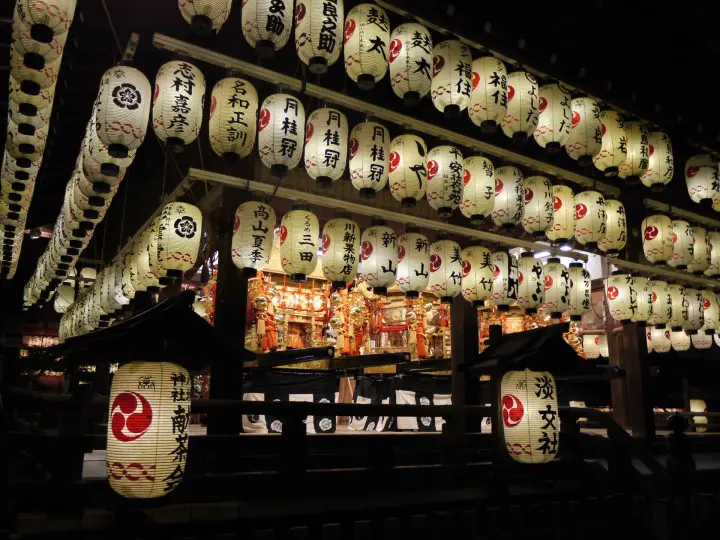
In order to enjoy Gion Matsuri to the fullest, there are three things you should be careful about:
No.1: Toilets
Although Gion Matsuri is one of the best known and largest festivals in the country, there are hardly any provisional toilets at the venue. We recommend using the toilets inside the train stations and convenience stores around the city.
No.2: Rain
Unfortunately, during this time of the year, it is not at all uncommon to have rain suddenly pouring down, especially during the evenings. Therefore, please make sure you have umbrellas or raincoats at hand, so you won’t have to worry about unexpected showers.
No.3: Money
If you plan to buy some food or souvenirs at the festival food stalls, make sure you have some change in your wallet. The shops and food stalls might not be able to give you change for large notes such as 10,000 yen, so make sure you have small change at hand.
FAQ
What does the Gion Festival celebrate?
The Gion Festival (Gion Matsuri) is a famous annual event in Kyoto, Japan, that celebrates the Yasaka Shrine. This festival has a history spanning over a millennium and is considered one of the most important and popular festivals in Japan. It takes place throughout the month of July, but its main events occur in mid-July. The Gion Festival originally began as a purification ritual to appease the gods during times of plague and other disasters. Over time, it evolved into a grand celebration featuring parades, traditional music and dance performances, processions of floats known as "yamaboko," and various ceremonies. One of the highlights of the Gion Festival is the Yamaboko Procession, where elaborately decorated floats are paraded through the streets of Kyoto. These floats, some of which are several stories tall, are meticulously crafted and adorned with tapestries, sculptures, and lanterns. The festival draws huge crowds of both locals and tourists who come to witness the spectacle and enjoy the festive atmosphere. Overall, the Gion Festival is a vibrant and colorful celebration that showcases the rich cultural heritage of Kyoto and Japan as a whole.
What time does the Gion Festival start?
The Gion Festival in Kyoto typically spans the entire month of July, with various events and activities taking place throughout this period. However, the main events, including the Yamaboko Junko procession of the floats, generally occur on specific days in mid-July. The Yamaboko Junko parade, which is one of the most iconic parts of the Gion Festival, usually takes place on July 17th and July 24th each year. These are the two days when the beautifully decorated floats are paraded through the streets of Kyoto. The exact start time of the Gion Festival events can vary each year, and it's best to check the official schedule or local announcements for the most up-to-date information. Typically, the procession starts in the morning at 9:00 AM and goes on throughout the day, so if you plan to witness this grand parade, it's advisable to arrive early to secure a good viewing spot along the route.
Do you need tickets for Gion Matsuri?
The Gion Matsuri, one of Japan's most famous festivals held in Kyoto, generally does not require tickets for many of its events, particularly the public spectacles like the Yamaboko procession. This parade, where the lavishly decorated floats are paraded through the streets, is typically open to the public to watch for free along the designated parade route. Because Kyoto's streets become very crowded during the Yamaboko procession, those who wish to view the parade in comfort and safety, can book a reserved seat on Klook.
Some other aspects of the Gion Matsuri may require tickets or reservations, particularly if you want to attend specific performances, exhibitions, or ceremonies that are part of the festival. These events may have limited seating or require advance bookings due to high demand. If you are interested in participating in certain events that require tickets or have limited access, it is advisable to check the official Gion Matsuri website or contact the organizers for information on how to secure tickets or make reservations for those particular activities.
What is the biggest festival in Kyoto?
The Gion Matsuri is widely regarded as one of the biggest and most famous festivals in Kyoto, Japan. This annual event, held in honor of the Yasaka Shrine, is deeply rooted in the city's history and cultural heritage. The Gion Matsuri takes place throughout the month of July, with the main events, including the spectacular Yamaboko Junko procession featuring ornate floats, happening in mid-July. The festival draws millions of visitors each year from Japan and around the world, making it a significant and vibrant celebration of Kyoto's traditions and community spirit. The Gion Matsuri is not only a major cultural event but also a key part of Kyoto's identity and a symbol of its rich history. While there are other notable festivals in Kyoto, such as the Aoi Matsuri and the Jidai Matsuri, the Gion Matsuri stands out as the biggest and most iconic festival that captures the essence of Kyoto's cultural heritage and tradition.
Is Gion Matsuri worth it?
Attending the Gion Matsuri in Kyoto is a highly recommended experience due to its profound cultural richness and historical significance. This festival, rooted in over a millennium of tradition, offers a vibrant atmosphere with traditional performances, ceremonies, and the grand Yamaboko Junko parade. The event provides a unique opportunity to witness Japan's cultural heritage firsthand, offering stunning photo opportunities and a chance to immerse oneself in the festive spirit of Kyoto. The Gion Matsuri not only showcases the grandeur of the floats and the intricacies of the rituals but also allows attendees to engage with Japanese customs and traditions in a way that is both captivating and enlightening. For those interested in Japanese culture, the Gion Matsuri is a must-see event that promises a memorable and culturally enriching experience.
Enjoy Kyoto's Gion Matsuri!
Gion Matsuri is the pride of Kyoto, boasting a history of at least one thousand years. How about experiencing it firsthand the next time you visit Kyoto?
Gion Festival
Venue: Yasaka Shrine in Gion, Kyoto Google Map
Schedule: every year July 1 - 31, with the main parades on July 17 and July 24
Official website: http://www.yasaka-jinja.or.jp/en/gion.html
Read also
Mian image courtesy of Klook © Kyoto City Tourism Association
This is the official account of MATCHA's editorial department. Our articles feature useful travel information for visitors to Japan, from how-to guides to recommended places to visit.













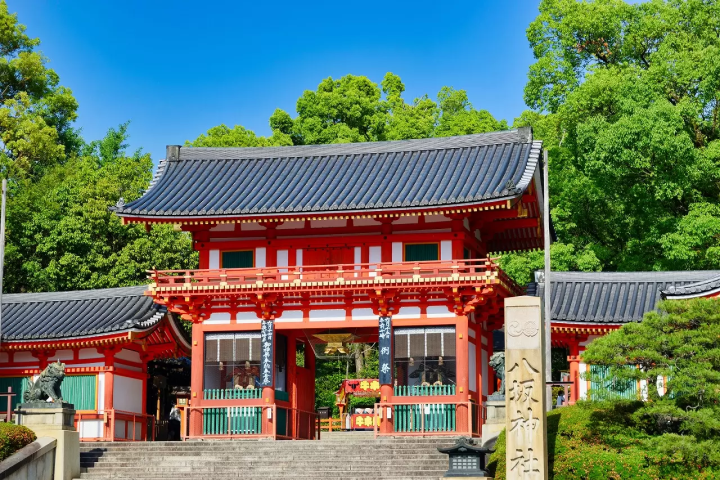































![[2026] Top 5 Strawberry Picking Spots in Tokushima, Naruto| Farms and Access Guide for January to May](https://resources.matcha-jp.com/resize/720x2000/2025/03/06-227165.webp)
![[Yamanashi/ Hokuto City] 4 Hot New Spots Opening in 2026](https://resources.matcha-jp.com/resize/720x2000/2025/12/12-252747.webp)


